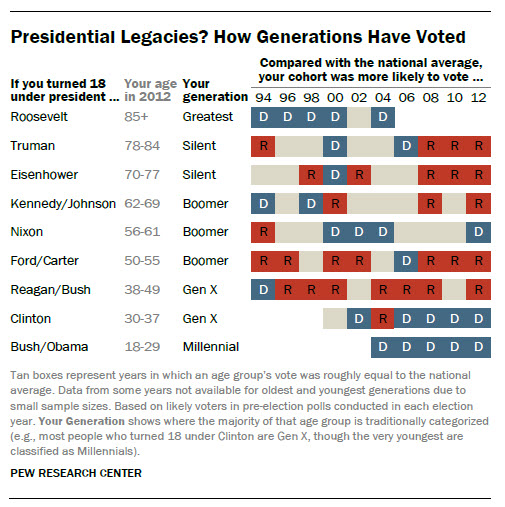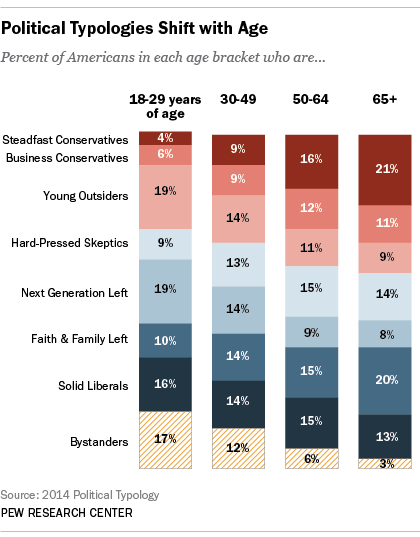Our approach to generational analysis has evolved to incorporate new considerations. Learn more about how we currently report on generations, and read tips for consuming generations research.
The notion that age and political ideology are related goes back at least to French monarchist statesman François Guizot, who originated the oft-mangled quotation, “Not to be a republican at 20 is proof of want of heart; to be one at 30 is proof of want of head.” But data from the Pew Research Center’s new political typology report indicate that, while different age cohorts do have markedly different profiles, the relationship is considerably more complex than young=liberal and old=conservative.
The report, based on a survey of more than 10,000 Americans, finds that among the oldest Americans (those ages 65 and up), nearly two-thirds are at opposite ends of the typology. 32% fall into the two strongest Republican-oriented groups (what we call Steadfast Conservatives and Business Conservatives) and 33% are either Solid Liberals or Faith and Family Left, the two strongest Democratic-aligned groups. (Steadfast and Business Conservatives are separated mainly by the latter’s more Wall Street orientation, while the Faith and Family Left tend to be more conservative on social issues than Solid Liberals.)
Looking at the youngest American adults, those ages 18 to 29, nearly one-in-five are what we call Young Outsiders — GOP leaners who favor limited government but are socially liberal. Almost exactly the same percentage are what we’ve termed the Next Generation Left, who tilt more to the Democrats but are wary of social-welfare programs. And many (17%) are Bystanders — not registered to vote, don’t follow politics and generally the least politically engaged. That’s the biggest share among all age brackets, though perhaps not entirely surprising.
Steadfast Conservatives: Generally critical of government, especially social safety net programs, but also critical of big business and immigrants. Most are very socially conservative.
Business Conservatives: Overall, critical of government regulation and social-welfare spending, but not of big business. For the most part, moderate to liberal on social issues, with positive views toward immigrants.
Young Outsiders: Tend to be distrustful of government programs and fiscally conservative, but very liberal on social issues and not very religious.
Hard-Pressed Skeptics: Generally distrustful of government, except for social safety net spending. On average, low-income, anti-immigrant compared with other groups.
Next Generation Left: Generally positive feelings about government, but less so for social programs. Tend to be business-oriented and individualistic.
Faith and Family Left: By and large, highly religious, socially conservative, but strongly support social safety net and government action more broadly.
Solid Liberals: Overall, highly supportive of social programs, immigrants and government generally; very skeptical of business and markets. Consistently liberal on social issues, from homosexuality to environmental protection.
Bystanders: On the sidelines of the political process; not registered to vote and pay very little attention to politics.
[B]
A recent paper by two Columbia University researchers that combined multiple survey data sources finds evidence of this sort of generational imprinting. Their study identified five main generations of presidential voters, each shaped by political events during their formative years: New Deal Democrats, Eisenhower Republicans, Baby Boomers, Reagan Conservatives and Millennials. (The researchers note, however, that their model works best among non-Hispanic whites.) Amanda Cox of The Upshot (The New York Times’ data blog) has created a fascinating interactive visualization of the researchers’ model.
Pew Research Center surveys over the past two decades also have found compelling evidence that generations carry with them the imprint of early political experiences.

As Fact Tank noted last year, Americans who came of age during the Truman and Eisenhower administrations, and are now in their 70s and 80s, have fairly consistently favored Republican candidates, while those who turned 18 under Bill Clinton and his two successors have almost always voted more Democratic than the nation as a whole.

